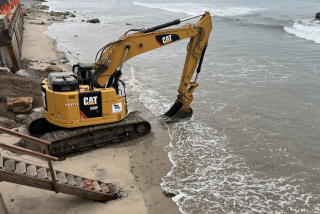The Case of the Disappearing Dune
Dennis Rodmanâs former stamping grounds in west Newport Beach are known as a neighborhood where residents -- who routinely complained to police about Rodmanâs rowdy parties -- relish peace and quiet.
But remarkably, few residents have said they heard anything when a 4-foot-high, 50-yard-long sand dune was flattened right in front of their ground-level decks late one April night, leaving some of the multimillion-dollar homes with an unimpeded ocean view.
The dunes have been a point of contention in the 7300 block of West Oceanfront, near the Santa Ana River mouth. Last year, a homeowner hired a crew to remove part of the dune, but was stopped by the city. Residents are staying mum about the duneâs demise, but most seem delighted itâs gone.
And unless the Orange County district attorneyâs office and Newport Beach police can find who bulldozed it, the city may have to dump thousands of dollars into replacing it.
The California Coastal Commission, which oversees development of the stateâs 1,100-mile coastline, has given the city until Aug. 18 to solve the mystery and find someone to pick up the tab, which Assistant City Manager David Kiff estimates âcould certainly be in the five figures, maybe in the six figures.â
Sand dunes, a vanishing landform in Southern California, are protected by state law. Restoration would include using biologistsâ reports to try to re-create the duneâs earlier configuration and monitoring plant growth.
Coastal Commission officials suspect one or several residents were involved, but residents will say only that they are happy itâs gone. The ice plant-dotted dune had gradually increased in size over the last decade, leaving some ground-floor residents without the ocean view they felt came with their address.
âWeâre pleased that itâs gone,â said Bob Ray, 80, whose blue-walled home with its second-story deck is adjacent to the spot of missing sand. âItâs a much better view.â
The average sprawling home on West Oceanfront easily sells for $3 million, and as prices have steadily increased over the last several years, so have the dunes, much to many residentsâ chagrin.
But there was nothing residents could legally do about it. Californiaâs 1976 Coastal Act requires a permit for any coastal development and limits alteration of natural landforms.
So someone took matters into his or her own hands, a move that has angered environmentalists.
âYou canât just go down and bulldoze,â said Mark Rauscher, environmental director of the Surfrider Foundation, a San Clemente-based environmental group.
Rauscher pointed to recent events in Malibu in which property owners used heavy equipment to scoop up tons of public beach sand and pile it on their private beach. It is the latest twist in a long-standing dispute over beach access between Broad Beach residents and beachgoers.
âThese sort of vigilante tactics show a lack of respect for the people of California and the resources that weâre entitled to protect,â he said.
âJust because they have money, they think they can do whatever they want to suit their needs.â
Nancy Gardner, who heads the foundationâs Newport Beach chapter, said, âItâs the publicâs beach. Itâs not your beach.â
But as a real estate agent, Newport Beach Councilman Steven Rosansky is more sympathetic to the plight of residents whoâve traded their ocean view for a sand dune.
âPeople who had an ocean view at one time and saw the waves crash on the beach feel like theyâre being cheated now because itâs no longer there,â he said.
A view can often make a big difference in a propertyâs value.
Standing on his second-floor deck, Ray pointed to the strip of houses to his right, four of which have ground-floor decks and face the area that once was a dune.
Residents there either refused to comment on the duneâs demise or werenât home.
âPeople have been wanting to do away with the dunes for a while,â Ray said.
Replacing the sand mound is a waste of money, he said. âYou can hardly see that itâs gone. I donât see that any damage has been done.â
But others say thereâs a good reason for all the fuss.
Many dunes, no matter how small, support rare ecosystems, and these dunes were close to one of the few successful breeding colonies of the California least tern, an endangered species, Coastal Commission officials say.
The duneâs disappearance may be linked to heavy machinery, owned by CJW Construction Inc., stored at a nearby site for a Santa Ana River dredging project. A site supervisor reported to police that a front-loader and excavator had been taken from the site and later replaced.
In a May 10 letter to the city, Andrew Willis, a district enforcement analyst for the Coastal Commission, said it appeared that nearby homeowners âorchestrated this destruction, possibly by hiring one of CJWâs employees âunder the table.â â
Alan Perkovich, CJWâs project manager at the site, insisted the equipment was used without the companyâs permission and that his employees were not involved.
If the city finds who did it, the culprit would not only be charged thousands of dollars in restoration fees but could also be fined for violating the Coastal Act, which could range from $500 to $30,000, Willis said.
More to Read
Sign up for Essential California
The most important California stories and recommendations in your inbox every morning.
You may occasionally receive promotional content from the Los Angeles Times.










